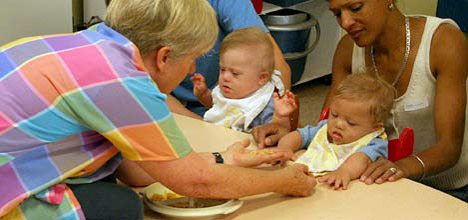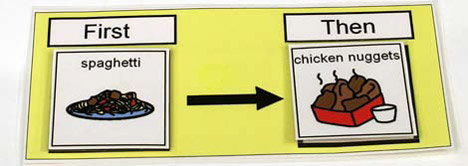
It is common for children to develop food preferences at some point throughout their childhood. However, there are children who will resist eating a variety of foods and will develop “definite food preferences”.
The following information will assist you as a parent, teacher or early childhood professional, in the identification of the “resistant eater”, will explain some possible causes of the problem, and will provide you with some suggestions that you may want to try with your child.
Characteristics of children with definite food preferences:
- They eat no more than fifteen types of food. It can actually be as low as two or three types, such as hot dogs, yogurt, and chicken nuggets.
- They eat foods from only one to three food groups.
- They become anxious (or may throw tantrums) when new foods are presented to them.
- They eat the same food prepared in the same way over a long period of time.
- They might have developmental delays and/or a medical diagnosis, such as Autism Spectrum Disorder, Cerebral Palsy, Muscular Dystrophy, etc.
Factors that may cause or contribute to eating problems and food aversions:
-
- Poor oral-motor skills. Children might have difficulty biting, chewing, swallowing, etc., which may lead to:
- drooling
- resistance to trying new-textured foods
- selective eating
- difficulty digesting food
- Poor oral-motor skills. Children might have difficulty biting, chewing, swallowing, etc., which may lead to:
Note- For children with poor oral-motor skills, it is very important to direct families to seek good medical advice before trying any new feeding strategies.
- Environmental and behavioural factors:
- fear of new foods – “Food Neophobia”
- unstructured mealtime environment (e.g., different schedules and settings, or distractions at mealtime)
- cultural beliefs/family practices (e.g., the child who is forced to eat or is punished for not eating; the child who is not supposed to explore the food with his fingers; the child who is fed until late in the preschool years)
- developmental challenges (e.g., lack of communication related to poor oral-motor development; the repetitive behaviours associated with Autism Spectrum Disorder, and cognitive delays).
- Sensory-based and motor-based factors:
- Sensory Processing Disorder – the brain has difficulty processing sensory information that comes from different parts of the body and/or from the environment.
What you can do to help a child develop healthy eating habits:
The following suggestions might help you and your “resistant eater” overcome his food aversions. Always remember that this process will take time, so you will need to be consistent in applying the strategies over and over again.
-
- Work in a team with other staff members and parents to support the child. You may want to start gathering information by asking questions regarding the child’s eating habits (what, when, where, for how long); health, medical history, allergies, and diagnosis. Then, you will be ready to develop a plan with the family so you can all start working together on the same goals. Review the goals often and adjust them as needed. Finally, consultation with a nutritionist and an occupational therapist should be discussed with the family. An occupational therapist can provide strategies to address poor oral-motor development and sensory issues that might be contributing to the child’s eating problem.
- The mealtime setting should be as predictable and consistent as possible. In the event of a change in the setting (e.g., a field trip), prepare the child for the change. You can discuss with the group when and where the lunch will take place, read a story about picnics, or prepare a short social story for the event.
- Ensure that the expectations at mealtime are clear for the child, and appropriate to his developmental level.
- Create and discuss the mealtime rules with the group
- Follow through with these rules
- Model/teach appropriate eating habits and skills
- Praise the child for trying new food(s)
- Food Selection
- Make a list of foods the child eats, foods the child used to eat in the past, and foods that he is not eating from the major food groups. This will provide a better sense of which foods to introduce or that are missing from the child’s diet.
- Introduce new foods one at a time and at the same time every day.
- Include in the menu foods from all food groups.
- Talk about the foods that are part of the menu (taste, texture, smell, colour).
- Prepare child-friendly foods that are healthy and tasty (for example fruit cocktail).
- Allow for choices from two to three healthy options.
- Offer at least one favourite food per meal, but slightly change the presentation.
- Go grocery shopping with the group and allow the child to pick the “new food” from a healthy selection.
- Create the “Menu of the Day” with the children. Discuss what foods will be offered at lunch time (include the one selected by the child).
- Cook the meal (or part of the meal) with the children, if you have the opportunity.
- Always offer small portions of the new food (served on child-sized dishes). Initially, the goal could be that the child would be exposed to the new food and would be able to manage his behaviour (no crying or tantrums) when the new food is on his plate. You can start by placing the new food close to the child, but on a different plate. When you start seeing signs of acceptance (accommodation to the new situation), try placing one to two scoops of the new food directly on the child’s plate. Always evaluate the child’s reactions, and praise him for appropriate behaviour.
- Create and use a First-Then visual board. This board will visually guide the child to the foods he will be offered for lunch. Include the new food as the First option and a favourite food as the Then option. The child should at least try one or two bites of the “first” food. When he does that, he can then eat the favourite food.

Note: Introduce the First-Then visual board after you notice that the child is feeling more comfortable with the “new food” experiences described above.
- Allow for sensory exploration of new foods through planned activities that are fun and enjoyable. Through sensory exploration, the child can be introduced to the new food slowly by looking at, touching, and smelling it, without the pressure of having to eat it. The child learns about the new food through activities that are interesting and pleasurable. Some suggestions of these sensory activities are:
- Sensory bag with two to four new food items
- Hot potato game with different foods (place the food in a bowl to pass it around)
- Smell and guess (blindfold or eyes closed); use new and preferred foods
- Grow a garden
- Use dry food ingredients for the sensory bin, art, and cognitive activities (e.g., counting, sorting)
Having a child with definite food preferences can be very challenging. It will be necessary to take the time to get to know the child and learn about his condition, think positively about changing the child’s habits, and give and take the time for the changes to occur.
References:
Ernsperger, L.; & Stegen-Hanson, T. (2004). Just Take a Bite: Easy, Effective Answers to Food Aversions and Eating Challenges. Future Horizons Inc.
